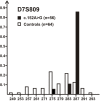DNAJC30 disease-causing gene variants in a large Central European cohort of patients with suspected Leber's hereditary optic neuropathy and optic atrophy
- PMID: 35091433
- PMCID: PMC9554085
- DOI: 10.1136/jmedgenet-2021-108235
DNAJC30 disease-causing gene variants in a large Central European cohort of patients with suspected Leber's hereditary optic neuropathy and optic atrophy
Abstract
Background: Leber's hereditary optic neuropathy (LHON) has been considered a prototypical mitochondriopathy and a textbook example for maternal inheritance linked to certain disease-causing variants in the mitochondrial genome. Recently, an autosomal recessive form of LHON (arLHON) has been described, caused by disease-causing variants in the nuclear encoded gene DNAJC30.
Methods and results: In this study, we screened the DNAJC30 gene in a large Central European cohort of patients with a clinical diagnosis of LHON or other autosomal inherited optic atrophies (OA). We identified likely pathogenic variants in 35/1202 patients, corresponding to a detection rate of 2.9%. The previously described missense variant c.152A>G;p.(Tyr51Cys) accounts for 90% of disease-associated alleles in our cohort and we confirmed a strong founder effect. Furthermore, we identified two novel pathogenic variants in DNAJC30: the nonsense variant c.610G>T;p.(Glu204*) and the in-frame deletion c.230_232del;p.(His77del). Clinical investigation of the patients with arLHON revealed a younger age of onset, a more frequent bilateral onset and an increased clinically relevant recovery compared with LHON associated with disease-causing variants in the mitochondrial DNA.
Conclusion: This study expands previous findings on arLHON and emphasises the importance of DNAJC30 in the genetic diagnostics of LHON and OA in European patients.
Keywords: eye diseases; human genetics.
© Author(s) (or their employer(s)) 2022. Re-use permitted under CC BY-NC. No commercial re-use. See rights and permissions. Published by BMJ.
Conflict of interest statement
Competing interests: None declared.
Figures




References
-
- Leber T. Ueber hereditäre und congenital-angelegte Sehnervenleiden. Graefe's Arhiv für Ophthalmologie 1871;17:249–91. 10.1007/BF01694557 - DOI
-
- Jacobi FK, Leo-Kottler B, Mittelviefhaus K, Zrenner E, Meyer J, Pusch CM, Wissinger B. Segregation patterns and heteroplasmy prevalence in Leber’s hereditary optic neuropathy. Investig Ophthalmol Vis Sci 2001;42:1208–14. - PubMed
Publication types
MeSH terms
Substances
LinkOut - more resources
Full Text Sources
Molecular Biology Databases
